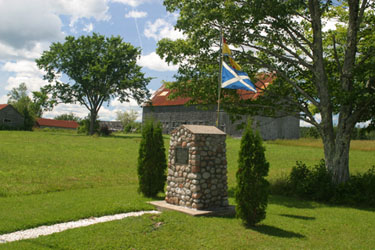

Chain Migration into Harvey Settlement
1840's – 1850's
Return To Genealogy Index
Last Updated: 7 April, 2008
Some friends and close relatives of the Cornelius settlers of 1837 arrived in the years following the establishment of Harvey Settlement but the numbers were not large. They primarily came from Northumberland and the Borders with very few arriving from elsewhere in Great Britain. These later arrivals primarily settled on lots in the outer tiers of Harvey settlement (e.g Moffitts, 1842). Several families (e.g., Swans, Rutherfords) arrived from Northumberland and the borders beginning in 1850 to take up lots in the Capt. John Campbell Block on the southern margin of Harvey Settlement for one dollar per acre. This 1,000 acre block bordering Oromocto Lake became known as Tweedside, named for the Tweed River in the settler's homeland. Other later arrivals, and members of the second generation of the Cornelius party, also obtained lands on the 1,500 acre Simonds and Beauchant tracts that straddled the road between Tweedside and Harvey.
A second group of settlers from the western Borders region came to the community from Dumfriesshire in the the western Borders region, influenced by the reports of five Little brothers from that area who camed to Harvey Settlement in 1840. A few other immigrant families also arrived in the community in the 1840's and 1850's independant of each other and previous waves of migrants.
The following "chain migrant" families moved to the Harvey Settlement area in the 1840's – 1850's:
Family Year Moved to
Harvey SettlementThomas Briggs & Margaret Darling 1840 James Swan & Jane Moody 1840 Thomas Craigs & Margaret Patterson 1841 Luke Craigs (son of Thomas Craigs) 1841 Isabella Craigs (daughter of Thomas Craigs) 1841 Marshall Robison & Jane Dickson 1842 John Moffitt & Ellen "Nellie" Davidson 1842 Thomas Speedy & Isabell Patterson (major revision 17 Jan 2009) 1842 William Craigs & Margaret Dixon 1843 Thomas Craigs & Margaret Reed 1843 Robert Piercy 1843 George Piercy & Ann Winter & daughter Jane 1844 Siblings Thomas & Mary Piercy 1845 Robert Burrell & Ann Piercy 1845 Henry Swan & Elizabeth Russell 1850 James Rutherford & Isabella Russell 1850 John Taylor (later married Elizabeth Swan) 1852 Archibald Rutherford & grown children 1852 George Cleghorn and Agnes Hogg (major revision 25 May 2008) 1853 Widow Janet "Jessie" (Cleghorn) Wood (major revision 18 June 2009) 1853-1861 Isaac Burrell & Alice Grieve 1854
Medium sized pop up image
700 X 467, 72 dpi, 150 kFull sized pop up image
3072 X 2048, 180 dpi, 3951 kThe Tweedside cairn was erected in 1950 on the shores of Oromocto Lake to commemorate the centenary of a settlement of later arrivals from the Scottish side of the border. They did not, however, constitute a single party that arrived in that year. Source: Tim Patterson (2005 Images)
Medium sized
pop up image
700 X 552,
72 dpi, 157 kFull sized
pop up image
1537 X 1212,
180 dpi, 1542 kThe main difficulty with attracting large numbers of new settlers to Harvey Settlement was the lack of additional suitable land for agriculture. The Harvey Settlement area consists primarily of a series of fertile rolling hills with swampy areas being found in the intervening low areas. The main settlement area was also bounded by extensive swampy and heath areas. Within fifteen years of the founding of Harvey Settlement most arable land in the area had been taken up. In their explorations of the area the settlers found addition hardwood ridges beyond Oromocto lake that were suitable for settlement. Unfortunately these areas proved to be too remote and not large enough to justify the expense of constructing the required roads. It was not until well into the 20th century when large-scale lumbering was carried out in these back areas that suitable roads were built. By that time there was little interest in homesteading.
A contract was signed in 1852 between the European & North American Railway Company to build a railway linking New Brunswick and Maine. By 1869 the section through Harvey Settlement was completed on the northern fringe of the original settlement area, and a train station erected. This station, later expanded in 1909, changed the entire character of Harvey Settlement. A village began to grow up in the area and several mills and stores were established, many run by people unrelated to other settlers in the community. Several hotels were also built where passengers from the trains would stay during layovers or for tourism. The settlement became known as Harvey Station, although it was not officially incorporated until 1966. Rail passenger service ceased in Harvey Station in the 1980's although rail freight still passes through the community.
Large regional schools were built in the village starting with the opening of Harvey Regional High School in 1947 and a regional elementary school in 1966. Students were bused into Harvey from a considerable geographic area that comprises areas that were once distinct settlements in their own right.
Information on modern Harvey Station can be obtained from the village homepage at:
http://www.village.harvey-station.nb.ca/
Contact: Tim Patterson at tim.patterson@carleton.ca with comments or to provide additional information.
Entry last updated: 13 Oct 2008

